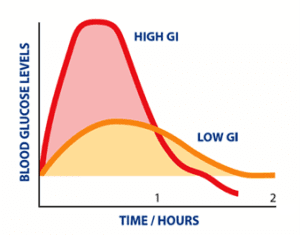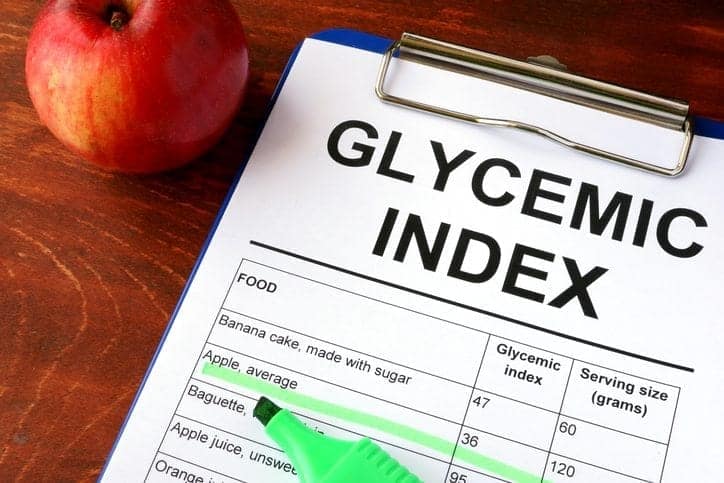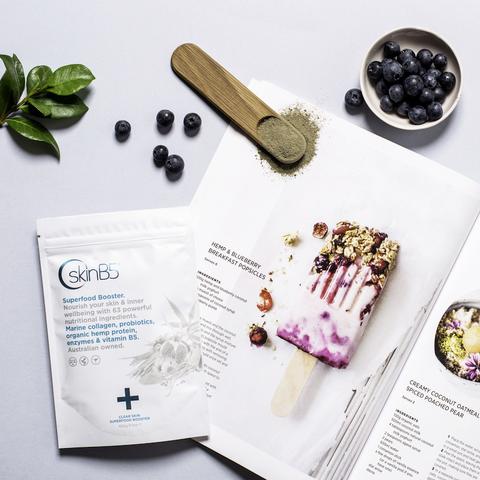There’s a reason why that little voice in our heads tells us to slow down on the chocolate and chips. When we consume a highly processed diet, that is, a high glycemic diet, it is likely we’ll experience those frustrating and consistent acne breakouts. Let’s take a look at what constitutes a high glycemic diet and its effect on acne.
What Is The Glycemic Index?
The Glycemic Index (GI) is the relative ranking of carbohydrates based on how they affect blood glucose levels when consumed. This index is broken into three parts: Low Glycemic Index (low GI), Medium Glycemic Index (medium GI), and a High Glycemic Index (high GI). Carbohydrates that rank 55 or less hold the Low GI title, whereas those ranking above 70 are classified as high GI.
The key difference between low GI and high GI is how long it takes carbohydrates to digest, absorb, and metabolise within our bodies. Depending on where these foods fall on the scale affects how much and how long our blood sugar levels rise when consuming them, as well as the amount of insulin is needed. The lower the GI rating, the more time it takes for our bodies to digest and absorb and the smaller the rise in our blood glucose levels. This also means we feel fuller for longer. The higher the GI rating, the quicker our bodies digest, the more blood sugar spikes, and the less satisfied we feel as we go about our day. Take a look at the clear difference between low and high GI in the diagram below sourced from GI Symbol.

What Makes Foods Low GI Or High GI?
It’s difficult to determine what constitutes the GI of food at face value. From close studies, experts have listed particular factors that have an impact on how fast or slow carbohydrates are absorbed in our bodies. Factors that affect a food’s Glycemic Index includes the type starch and sugar in the food, whether or not there is any fat accompanying the carbohydrate in the meal overall, the food’s viscosity (or thickness), and how the food is processed or cooked (for example, a sweet potato boiled for 30 minutes has a GI index of 46, whereas a sweet potato baked for 45 minutes has a GI index of 94).
High GI’s Effect On Acne
As outlined above, foods that metabolise faster produce higher levels of blood glucose and insulin levels. When these blood sugar levels are constantly spiking, especially long-term, our bodies are more susceptible to inflammation, insulin-resistance, weight gain, and increased hormone fluctuations which can affect oil production in the skin. These factors each result in a higher risk of painful and consistent breakouts and overall poor health.
As covered in our article What Is The Paleo Diet And Can It Help Acne, founder of the Paleo movement Dr. Loren Cordan studied two hunter-gatherer societies, the Kitavans and Aché, who each ate a low GI diet and had no signs of acne. This is a fantastic example of how our diets help or hinder acne breakouts.
Which Foods To Avoid
It is important to note that some foods that rank higher on the Glycemic Index actually offer nutritious value including powerful antioxidants, and should be enjoyed in a balanced diet. It’s also just as important to note that not all foods that rank lower on the GI scale aren’t necessarily nutritious (Peanut M&Ms only hold a GI of 33). Therefore, it is important to not only consider the GI of the food, but how refined it is, how fresh it is, and what goodness it can offer your skin and entire body.
Some examples of refined high GI foods you should avoid consuming frequently include the following:
- White bread (71)
- Baked potato (85)
- Durum spaghetti (78)
- Maltose (maltodextrin), pure, 10g (105)
- Gatorade (78).
To find out how other foods rank, take a look at this detailed Glycemic Index.
The Bottom Line
All in all, refined foods are typically high GI. When we constantly consume these types of food, acne can flare up, and we will likely notice overall poor skin and body health. While looking through the Glycemic Index, it is always important to consider the nutritional content of the food, not just it’s rating on the index.
How does your diet affect acne? Do you follow the Glycemic Index carefully when choosing your meals? Continue the conversation over on our Instagram and Facebook page.








Leave A Comment